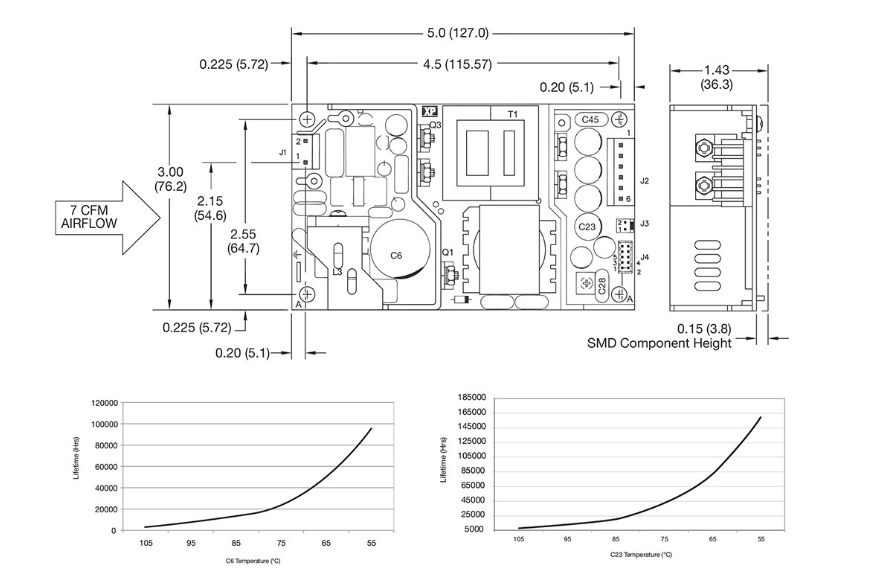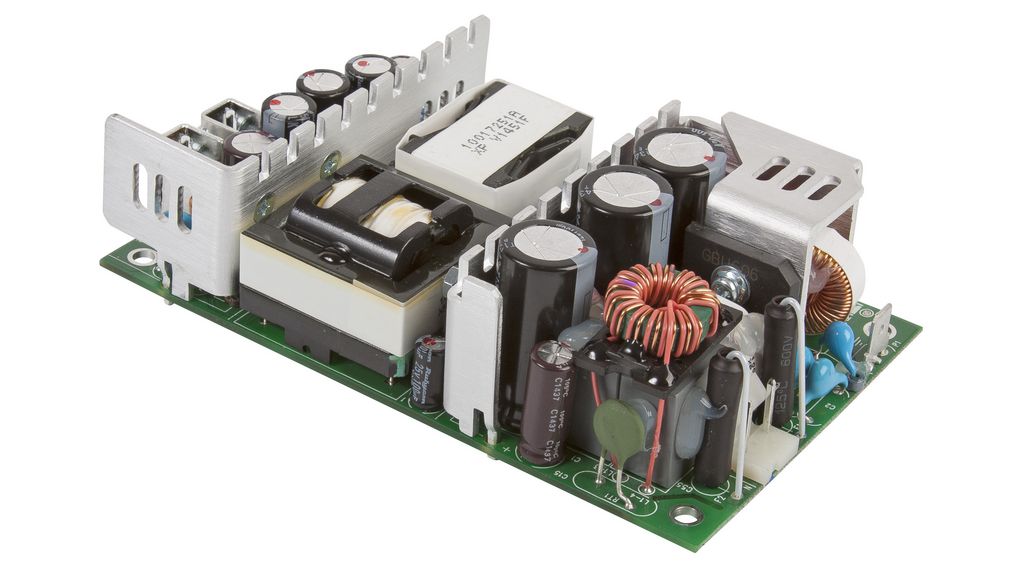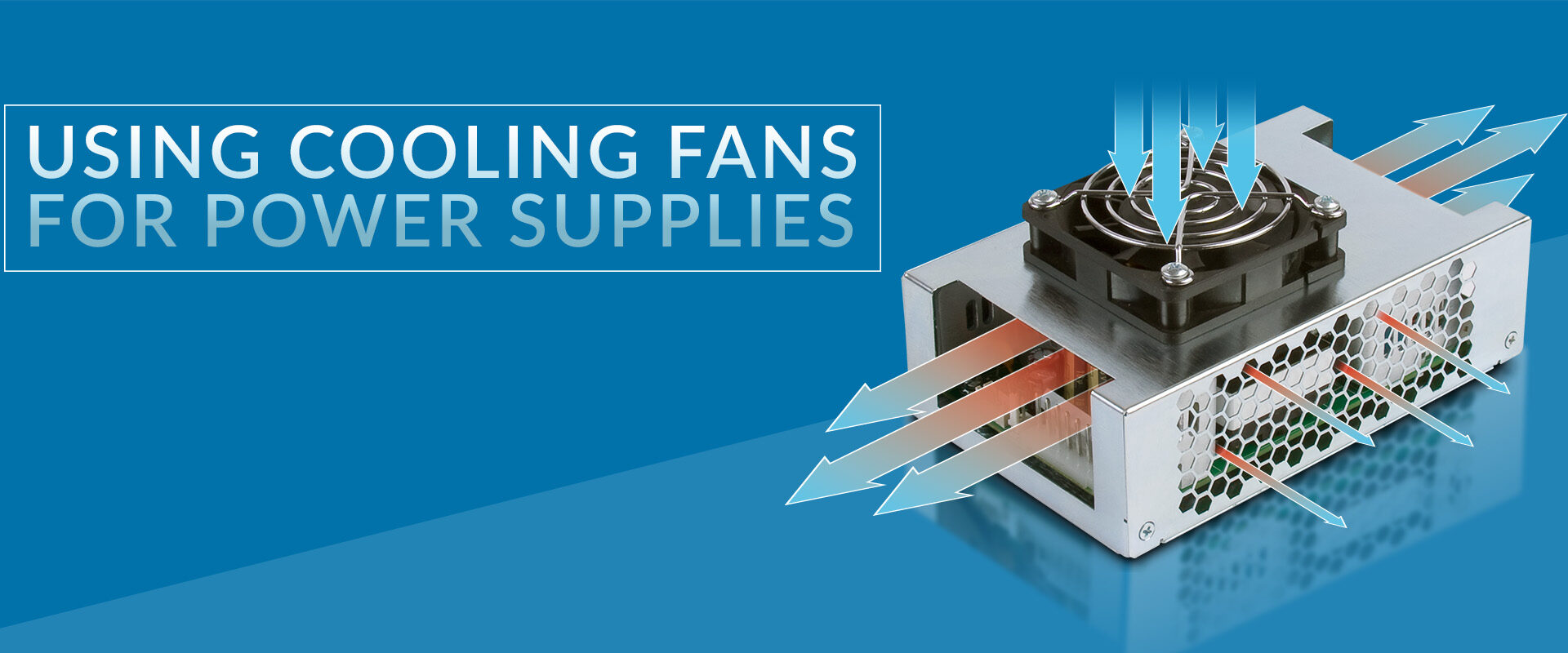Cooling fans are essential for power supplies that need forced cooling to prevent overheating.
Overheating of devices can reduce the lifespan of otherwise perfectly functioning equipment. As the temperature rises and the power supply handles more load, it generates more heat, which can potentially surpass the maximum temperature the power supply can handle. To counter this, cooling fans are necessary. They help dissipate heat, ensuring the power supply operates within safe temperature limits. By effectively preventing overheating, cooling fans contribute to prolonging the lifespan of the power supply and safeguarding its reliable operation.
Read on to find out more about cooling power supplies, how they work and discover the features of highlighted products designed to minimise the no load power consumption and maximise efficiency.
How does cooling power supplies work?
Power supplies generate heat while operating and converting electrical power. The excessive heat can decrease the power supply performance and lifespan. Hence, cooling fans help dissipate this heat and ensure the power supply works within its operating temperature.
Often, power supplies units (PSU) have built-in cooling fans whereas others are designed to be force-cooled or convection cooled. While convention cooling uses free air, force cooling uses external fans to lower the temperature of the power supply. The main difference between these two is the power density dedicated for a specific efficiency. Typically, convection-cooled devices have a lower power density than force-cooled ones, taking up more space. It will be specified in the power supply’s data sheets whether it is convection cooled, forced air cooled, or both.
Airflow
Airflow is the movement of air within a power supply unit. Through intake and exhaust it facilitates cooling and maintains the optimal temperatures of any components within the PSU. It is important to calculate and control the airflow. To help you with that, explore some of the tips and hints on the use of cooling fans for power supplies from XP Power that we concluded below.
Calculating airflow
Depending on the temperature that the equipment runs on or whether the power supply requires an external fan cooling, there are two ways to calculate airflow.
Firstly, calculate airflow by measuring the maximum operating temperature. The power supply itself typically has a maximum operating temperature, often around 50°C, which is determined by safety approvals or the need to enhance component longevity. It is generally observed that for every 10°C decrease in the temperature of an electrolytic capacitor case, the power supply’s lifespan doubles.
Secondly, determine the power dissipation. The power used in the load and the power lost by the power supply (waste heat) is the total power dissipated inside the enclosure. Following the XP Power example, assuming that the power supply is 80% efficient and the load taken by the electronics is 260 W, its total heat dissipated is 260 W / 0.8 i.e. 325 W. To calculate that it is useful to use a universal formula (see Figure 1).
Controlling airflow
Controlling airflow is not as straightforward as calculating, so following the above calculations might help you choose an appropriate rating for the fan airflow. However, the enclosure should have a natural resistance to airflow, known as pressure drop.
The pressure drop refers to the decrease in air pressure as it flows through a system or device. It occurs due to resistance encountered by the air as it passes through PCBs, filters, vents and ducts. The pressure drop can vary depending on the size of the PCB or vent, and the area where the air flows through.
The pressure drop can impact the overall efficiency and performance of the airflow system so it is important to correctly calculate the airflow. But determining the actual pressure loss for every application might be too complex, thus each manufacturer publishes a graph for every fan showing the air flow at varying pressure drops.
For more guidelines about how to calculate the pressure losses, read the XP Power blog.
Force-cooled power supply airflow
In terms of a force-cooled power supply, for accurate and dependable operation, the amount of air flowing over is essential. The fan of choice will need to have a significantly higher rating if it cannot be placed directly at the power supply or if the full airflow cannot be directed over it.
Fan specifications can be given in different units such as linear feet per minute (LFM), cubic feet per minute (CFM), or cubic metres per hour (m3/hr). Converting between these units requires knowledge of the cross-sectional area of the fan vent system. In the case of force-cooled power supplies, the required airflow can be provided as either a speed rating, such as LFM or a volumetric rating – CFM.
Managing power supply lifetime
Although designers take various factors into account to ensure an adequate product lifetime, manufacturers might not include all of the specific aspects, like mission profile, environment, applied load, mounting orientation, system cooling/ venting, etc. As a result the lifetime of some of the components within a PSU should be reassessed based on the specific installation conditions.
Operating temperature
A good indication of the power supply lifetime is its operating temperature so data sheets now provide crucial information for equipment designers, including specific maximum temperatures for various components. This ensures that power supplies are not operated at excessively high temperatures. Checking the temperature, for example, of capacitors in the data sheet helps indicate the expected service life (see Figure 2).

After determining the necessary pressure drop and airflow, in the context of general equipment cooling, it is important to ensure that the fan is positioned in a way that allows the airflow to pass through the heat source components. As long as this requirement is met, the fan can be located anywhere within the system.
When the appropriate fan is selected, a final verification should be conducted by measuring the temperatures of these components in the final configuration. If it appears that the component temperature might exceed the specified value in the data sheet, it is advisable to re-evaluate the airflow and direction to prevent potential issues.
Filters
Another thing to bear in mind when managing a power supply are filters. Filters are frequently used in equipment with fans to stop dust and any other particles from entering. These must be considered since they will increase the airflow’s resistance and cause pressure loss. A fan with a reasonable rating at the start of operation can end up being the wrong option after time of usage because, more crucially, when the filter becomes clogged with dirt, the pressure loss may increase dramatically. Dust filters need to be cleaned or changed on a regular basis for this reason.
Minimising the noise
Often, fans make a piece of equipment audibly noisy which is difficult in specific applications, like medical (where among industrial and ITE settings, the GCS series is used) or in recording studios, where no noise can be accepted. It is typically preferable to minimise interferences like these, even for uses in a noisy setting. XP Power highlights various ways to accomplish this:
- Fan bearings – To reduce fan noise, choose a higher quality bearing like ball bearings, which solve wear and wobble issues and operate quieter than sleeve bearings. Ball bearings also have a longer lifespan. However, certain sleeve bearing fans with impregnated oil can also reduce noise and improve performance.
- Blade speed – A larger fan is quieter than a smaller fan with the same air volume due to slower blade speeds. Considering noise from fan blades passing fixed parts is important; even a slight separation between the finger guard and fan blades can reduce noise. Lowering the fan supply voltage reduces disturbances, as the fan speed is determined by the DC voltage supplied, and lower speeds result in less audible noise.
The importance of cooling fans for power supplies
In conclusion, cooling fans are essential for power supplies because they regulate temperature, protect components from damage, prevent thermal shutdown, and contribute to the overall longevity and reliability of the power supply.
Recommended products
Switched-mode power supply, XP Power
The GCS line of switched-mode power supply is built to improve efficiency while minimising no load power consumption. The series is designed with the latest environmental legislations, approved for Class I and Class II. It offers single output models with efficiency up to 94%, single-fusing for IEC 60601-1 compliance, and single output variants from 12 V to 56 VDC.

The source of this article originally appeared on: https://www.xppower.com/resources/blog/hints-tips-cooling-fans-for-power-supplies and has been repurposed for the KnowHow page with kind permission from XP Power.
XP Power is a leading provider of power solutions, including AC-DC power supplies, DC-DC converters, high voltage power supplies and RF power supplies.











